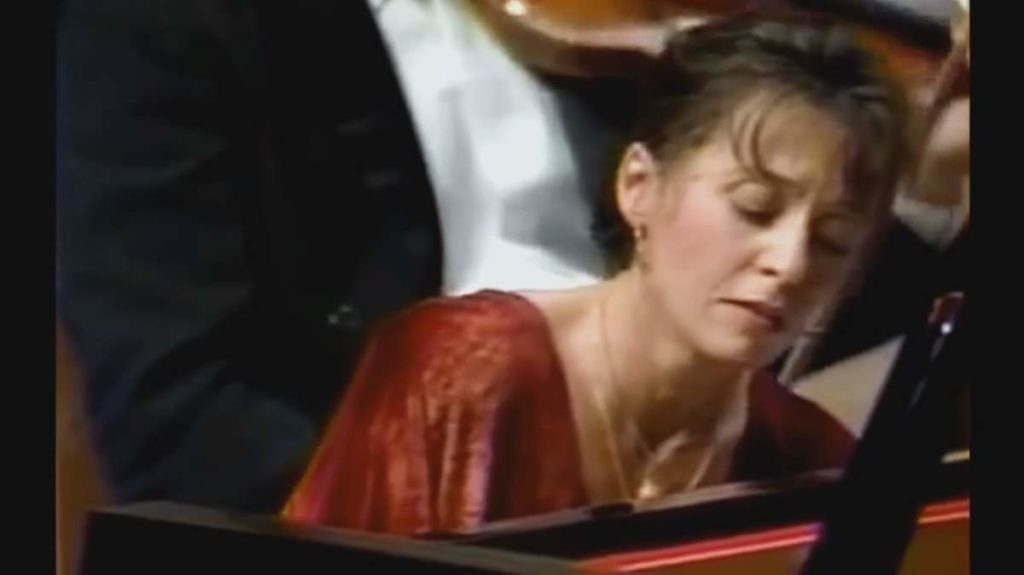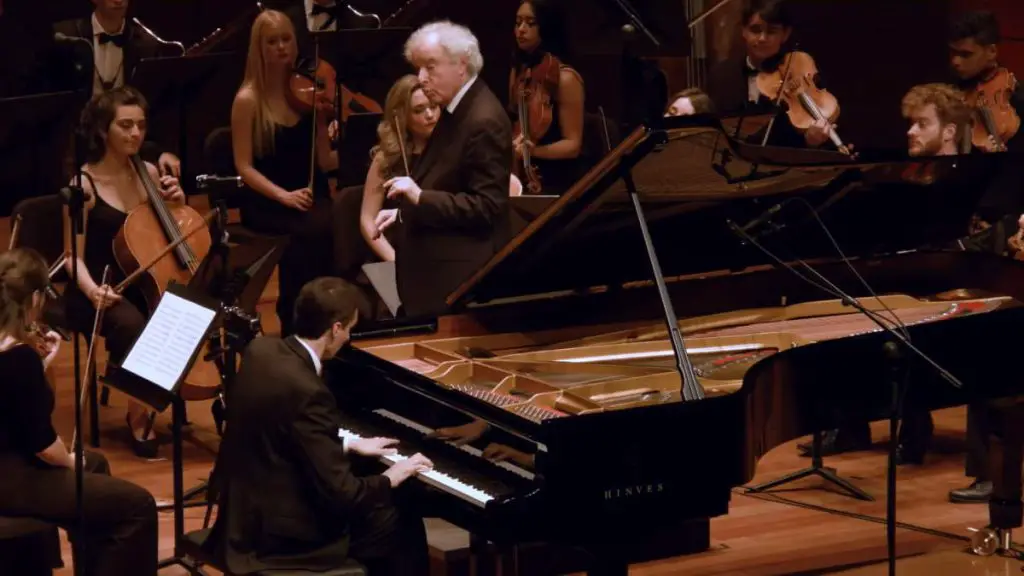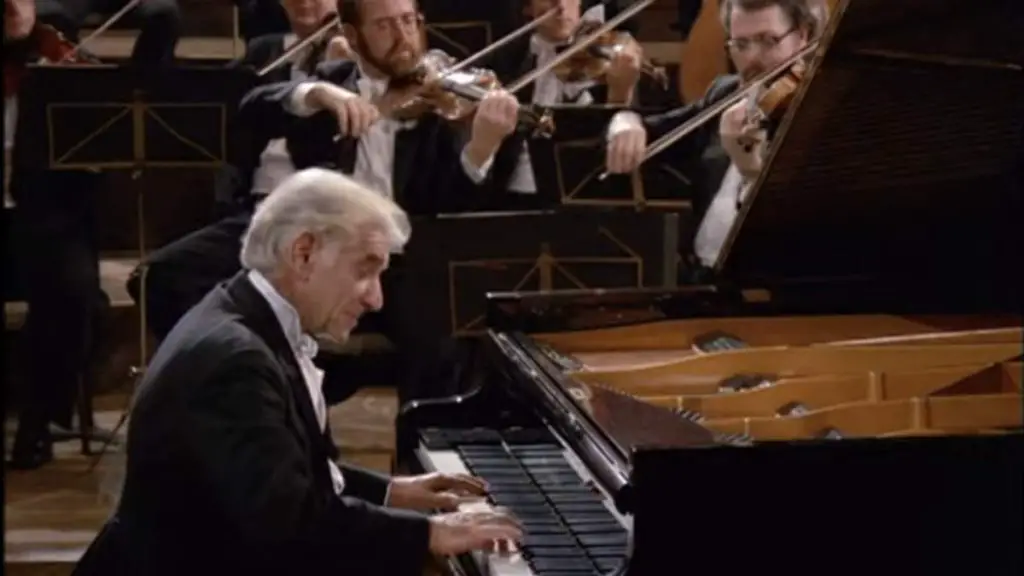Accompanied by the hr-Sinfonieorchester (Frankfurt Radio Symphony Orchestra), the German pianist Martin Helmchen performs Wolfgang Amadeus Mozart’s Piano Concerto No. 17 in G major, KV. 453. Conductor: Andrew Manze. Recorded at the hr-Sendesaal Frankfurt on June 3, 2021.
Mozart’s Piano Concerto No. 17
Piano Concerto No. 17 in G major, K. 453 was composed in Vienna in 1784. The concerto is scored for solo piano, flute, two oboes, two bassoons, two horns, and strings. This orchestration, especially the prominent role given to the woodwind instruments, was typical of Mozart’s piano concertos from this period.
This concerto is one of Mozart’s most popular and frequently performed. It is admired for its formal structure and balance between soloist and orchestra, as well as for its melodic invention. The interplay between the piano and the woodwinds is particularly noteworthy.
Piano Concerto No. 17 is also known for its cheerful, lyrical, and playful qualities. These are the traits that often come up when discussing the “Mozartean” style. The concerto reflects Mozart’s ability to blend diverse moods and styles within a single work, transitioning seamlessly between moments of joy, melancholy, and drama.
One of the historical anecdotes connected to this concerto involves a pet starling that Mozart reportedly purchased after hearing it sing a theme from the final movement of the piece. This story, while charming, has also sparked scholarly debate about the influence of birdsong on Mozart’s compositions.
Movements
Mozart’s Piano Concerto No. 17 follows the traditional three-movement structure (fast-slow-fast) common to concertos of the Classical period. With start times in the video:
- Allegro [00:00]
- Andante [12:25]
- Allegretto – Presto [23:02]
1. Allegro
The first movement of Mozart’s Piano Concerto No. 17 is marked as Allegro, indicating a fast and lively tempo.
The movement starts with a double exposition structure common in Classical-era concertos. The orchestra introduces the main themes of the movement before the piano enters with its own exposition, presenting these themes in its own unique way. The thematic material is known for its melodic beauty and brilliance, showing Mozart’s skill in thematic development.
One distinctive characteristic of this movement is the rich and elaborate interaction between the soloist and the orchestra. The interplay between the piano and the orchestra is often described as dialogue. The exchanges between the piano and the woodwinds are particularly memorable, emphasizing the overall cheerful, lyrical mood of the movement.
Another notable aspect of the first movement is its dramatic use of contrast. Mozart juxtaposes major and minor keys, fast and slow tempos, and varying dynamics, contributing to the movement’s high emotional range. The formal structure is also impressive, with Mozart playing with listeners’ expectations through his inventive treatment of the sonata form.
Throughout the movement, Mozart effectively balances the virtuosic elements with lyrical ones, creating an engaging musical experience that retains its charm and appeal centuries after its composition.
As always with Mozart, the cadenza towards the end of the movement is an opportunity for the pianist to showcase their technical and interpretive skills. It should be noted that Mozart wrote his own cadenzas for this concerto, but performers often choose to play their own or others’ cadenzas.
2. Andante
The second movement of Mozart’s Piano Concerto No. 17 is marked as Andante, which suggests a moderately slow tempo.
This movement offers a striking contrast to the vibrant energy of the first movement. It’s in C major, which creates a warm and tender mood. This movement is often described as serene, graceful, and lyrical.
While the first movement showcases the soloist’s virtuosity and the lively dialogue between the piano and orchestra, the second movement shifts the focus toward the expressive and melodic capabilities of the piano. The piano part is characterized by its singing quality, with long, lyrical lines that require great expressiveness from the performer.
The orchestra’s role in this movement is also notable. It provides a delicate accompaniment to the piano, contributing to the overall elegance of the movement. The woodwinds, in particular, add color and texture to the orchestral accompaniment.
The structure of the movement is a simple ternary form (ABA), where the opening section (A) presents the main melodic material, followed by a contrasting middle section (B), and then a return to the opening material. This clear structure is typical of slow movements in Classical concertos.
The mood of the second movement is introspective and peaceful, offering a moment of calm before the lively finale. As with all of Mozart’s music, the beauty lies not just in the melody itself, but also in the way it’s developed and varied throughout the movement.
In all, the second movement of Piano Concerto No. 17 is a wonderful demonstration of Mozart’s ability to write music of great depth and beauty, showcasing his mastery of melody and his understanding of the expressive potential of the piano.
3. Allegretto – Presto [23:02]
The finale of Mozart’s Piano Concerto No. 17 is marked Allegretto – a moderately quick tempo – and is set in the original key of G major.
This movement is a playful and lively finale that displays Mozart’s wit and charm. It follows the rondo form, which is a musical structure often used in the final movements of classical concertos. In a rondo, a principal theme (the A section) alternates with contrasting themes (such as B, C, etc.). The general pattern can be described as ABACA, or even longer.
In the case of this piano concerto, the main rondo theme is a catchy and charming melody that is instantly recognizable. The contrasting sections provide variety and intrigue, displaying Mozart’s imaginative handling of the rondo form.
This movement, much like the first, features notable exchanges between the piano and the orchestra. The textures are light and the mood is generally cheerful and buoyant, but as always with Mozart, there are moments of surprising depth and emotion hidden among the playfulness.
The piano part is virtuosic and requires a brilliant touch, but also a strong sense of timing and humor to bring out the full character of the music. As in the first movement, the performer has the opportunity to play a cadenza, showcasing their technical prowess and interpretive skills.
Interestingly, this is the movement that Mozart’s pet starling was said to have sung, leading to speculation about the influence of birdsong on his music.
In conclusion, the third movement of Mozart’s Piano Concerto No. 17 provides a delightful ending to the concerto. Its charm, vitality, and cleverness are representative of Mozart’s unique style, and it shows why his music has remained so popular over the centuries.
Martin Helmchen
Martin Helmchen was born in Berlin in 1982. He began his piano studies at the age of six and graduated from the Hanns Eisler Music Conservatory as a student of Galina Iwanzowa, and in 2001 from the Hochschule für Musik und Theater Hannover as a student of Arie Vardi.
He was a featured soloist in the BBC New Generation Artists program from 2005 to 2007. Helmchen has given concerts with the San Francisco Symphony, the Vienna Philharmonic, the Deutschen Symphonie-Orchester Berlin, and the NHK Symphony Orchestra.
His specialty is chamber music, where he has performed extensively with Heinrich Schiff and Marie-Elisabeth Hecker. Collaborations with further artists have included Gidon Kremer, Christian Tetzlaff, Sharon Kam, Tabea Zimmermann, Juliane Banse, Julia Fischer, Sabine Meyer, and Lars Vogt.

He made his American debut in 2011 when he played at Tanglewood with the Boston Symphony Orchestra. The same year he performed with Dohnanyi and the Chicago Symphony Orchestra.
In 2001 he won the Clara Haskil International Piano Competition. In 2003 he won the International Kissinger Klavierolymp Competition, related to the festival Kissinger Sommer.
In 2006 he was awarded the Crédit Suisse Award, for his debut with the Vienna Philharmonic, directed by Valery Gergiev, playing Schumann’s Piano Concerto at the Lucerne Festival.
Again, in 2006, he received the ECHO Klassik Prize as together with cellist Danjulo Ishizaka for their CD with works from Felix Mendelssohn, César Franck, and Benjamin Britten (2005, Sony Classical).
Sources
- Piano Concerto No. 17 (Mozart) on Wikipedia


![Mozart: Piano Concerto No. 17 [Fortepiano: Kristian Bezuidenhout, Freiburger Barockorchester]](https://cdn-0.andantemoderato.com/wp-content/uploads/2016/09/Mozart-Piano-Concerto-No-17-Fortepiano-Kristian-Bezuidenhout-1024x576.jpg)
